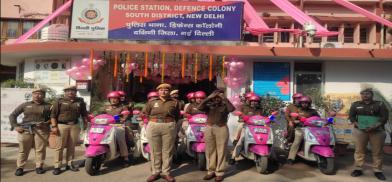Need for more women in India's police force
According to a June 2018 study, the opening of all-women police stations in India led to an 11 percent increase in crime reporting. This is because the women population - particularly in rural and semi-rural areas - is more comfortable approaching these stations.

Over the last few years, women's role in Indian society has undergone a dramatic and positive transformation. Their roles have shifted from conventional homemakers to professionals. The number of Indian women participating in every economic activity has increased significantly over the past decade.
In the police, which demands long and unpredictable hours, women were seen to be unfit for such a career since their traits did not match with that of a police officer. Men still make up the majority of the police force while women are underrepresented in field operations. It is estimated that only 12 percent of Indian police officers are female as of 2020.
Several states have mandated 10-33 percent female reserves in the police departments but none have been successful. The percentage of women at higher levels is significantly lower -- 8.7 percent. Patriarchal attitudes have an adverse effect on a large number of female police officers.
There is a current exigency for women in the police. There are several reasons why women are essential in the police force.
1. Improved police-community relations can be facilitated by women officers.
2. The use of excessive force by women is less common.
3. Women feel more at ease attending women-run police stations than normal police stations, especially when dealing with women-related matters.
For this paper, I will only be focusing on the third point.
In a women-run police station, women would be more comfortable reporting cases like dowry harassment, sexual harassment, assault, bigamy, eve-teasing and domestic violence than they would in a police station with men as officers. In response to an RTI request, it was found out that 100 police officers were convicted of rape in the previous 10 years.
In an even more alarming development, a deputy sub-inspector was found to have committed rape under the guise of marriage. It takes scary incidents like these to make us women uncomfortable reporting crimes to policemen.
I think of domestic violence as the first issue that comes to mind when I think of women's (criminal) issues. Females have the ability to better relate to and understand other females in comparison to males. When it comes to domestic violence, female officers are more likely to take such offences seriously and act. It was viewed as a personal affair rather than a police department one by several police units.
Domestic violence reports increased by 13.6 percent with a 7.4 percent increase in female officer representation; also, domestic violence reports increased by 13.6 percent with a 7.4 percent increase in female officer representation. A female victim of domestic violence or another type of violence or sexual assault may feel more comfortable reporting the crime to a female officer.
In particular, victims may feel ashamed when reporting sexual crimes, especially if they are worried about being judged. It can be particularly difficult and emotionally traumatic for a woman to discuss abuse she has suffered with a male officer if she has been abused by a man. Women are capable of understanding other women's struggles.
The Indian laws have also taken into account the female population, recognizing the convenience of women reporting to woman officers. “Every case of sexual assault must now be registered and investigated by a female police officer under the Prevention of Children from Sexual Offenses (POCSO) Act and other significant criminal statutes.” With this woman's arrest and search, it must be carried out only by a woman. Women police officers are also seen to be better at dealing with juvenile delinquents because they are more empathetic and communicative with children.
This issue even led to the establishment of women police stations (WPS) in various districts. In dealing with domestic violence and other crimes against women, WPS is recognized as a crucial component of gender-sensitive policing. Many developing countries have established these stations to better deal with the plight of women, as well as to provide women officers with a rewarding career.
According to a June 2018 study, the opening of all-women police stations in India led to an 11 percent increase in crime reporting. This is because the women population - particularly in rural and semi-rural areas - is more comfortable approaching these stations. The number of women reporting violence committed against them increased by 21.4 percent in areas with a WSP, according to a city-level analysis, a 22.5 percent jump also occurred at the state level.
With this, a growing number of women are hired by police departments in addition to establishing more WPS. Women made up 15 percent of the police force in India between 2015 and 2016, going from around 123,000 to over 140.000. Compared to other police departments, WPS officers exhibit less skewed gender norms about women's roles or tolerance for violence against women. There needs to be more such stations as the number of FIRs increased after they were established.
Women in the police is a current exigency, suggests the National Crime Records Bureau (NCRB) data. While the number of women in the police has increased from 2 percent in 2001 to 7 percent in 2016, it is still insufficient to properly address gender-related offences. In 2016, around 11 percent of crimes under the IPC were committed against women, according to the National Crime Reporting Bureau.
Furthermore, even doing the simple mathematics, if there is not a minimum representation of women in the police force, not only will different laws be disregarded but the day-to-day management of public order (involving women) will not meet public expectations. The problem has not improved or been addressed. The CRPF has deployed women's battalions in Bastar to deal with the Maoists. As a result, complaints of wrongdoing against female agitators and Maoists will be minimal or non-existent.
For police stations to be able to effectively deal with crimes committed against women, about one-third of their staff should be women. The effectiveness of women police officers is mainly due to their use of minimal brawn and the fact that they are better at communicating with the general public. Each station must have adequate infrastructures, such as women's restrooms and separate toilets which will make the female officers more comfortable.
A traditionally patriarchal police force will become more sensitive to the problems of women by making their stations more accessible and approachable to women. A police officer must not be viewed as a muscle man; it is imperative to relax the recruitment policy to encourage more women to join the police so that women feel safe entering police stations.
India's police force has only seven percent, women, though women make up almost half our population. Therefore, how can it be considered a citizen's police force? To ensure the safety of all parts of society, I think the police force must be representative of society's various sections.
(The author is a 4th year law student at OP Jindal Global Law School. Views are personal. She can be contacted at aasthagupta9092@gmail.com)










Post a Comment